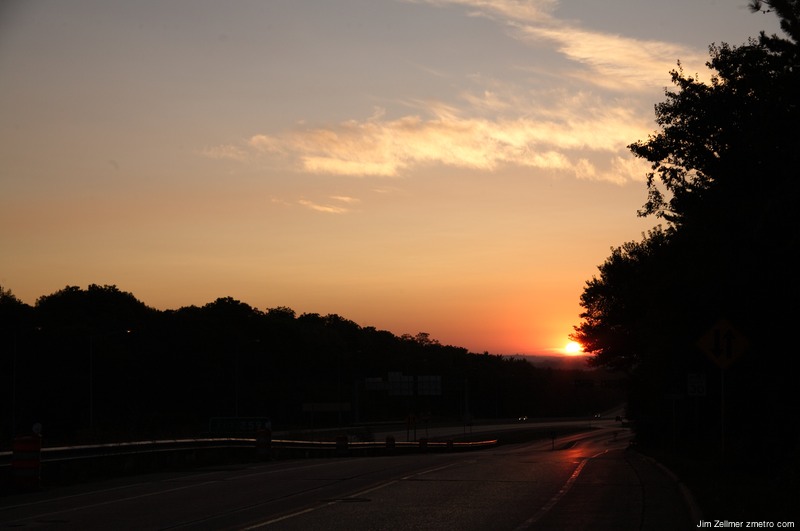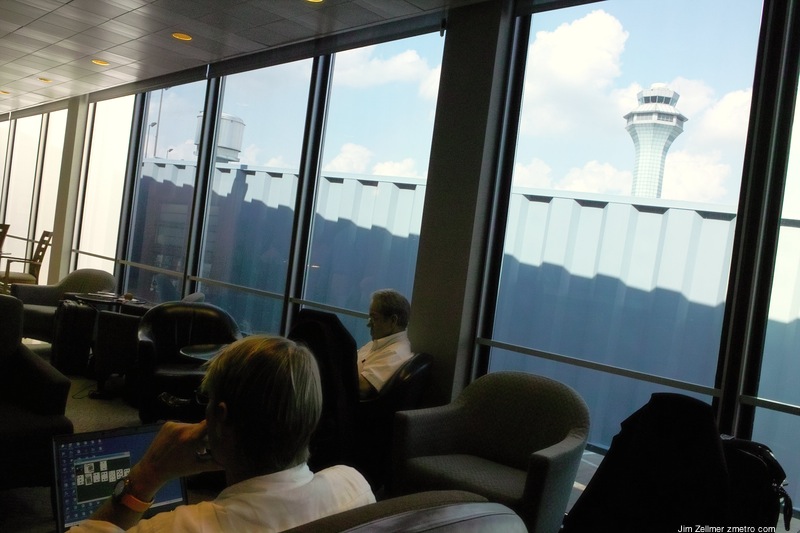
Flyover Country; a sunrise view from Fitchburg.
Category: Transportation
Sunrise: Madison “Beltline” Highway

Air Travel: 2008 – A Time When Standing Still Dominates

This is one of those moments when a camera in hand meets a scene waiting to be photographed: a beleaguered traveller resorting to solitaire on his PC while waiting for the promised next flight. The blue sky ignores the chaos below. Air travel is certainly, as a fellow passenger lamented, “not what it once was”.
Flight’s 100 Greatest
It is always a slightly nerve-racking moment for an editor to commission a reader’s poll. Quite simply, what happens if so few people participate that the exercise becomes a farce?
It very quickly became apparent that no such ignominy awaited the 100 Greatest exercise marking Flightglobal.com’s print edition, Flight International’s centenary. Votes poured in for your choices in the fields of most influential Civil Aircraft, Military Aircraft, Person, Engine and Moment.
By the time the poll closed on 20 June, no fewer than 18,000 of you had voted – thank you for having taken the trouble to do so and making this a more than worthwhile exercise.
Space is always limited in any publication, so the temptation to write mini-articles on every entry in our list had to be resisted. To those of you whose favourite personality or piece of machinery does not receive the words you feel he, she or it derived, our apologies.
#1: Apollo 11 Moon Landing
#2: Boeing 747
#3: The Wright Brothers
Why Rivals Don’t Copy Southwest’s Hedging
David Carter, an associate professor of finance at Oklahoma State, has an interesting perspective on why rivals haven’t caught up to Southwest. Prof. Carter helped write a 2004 case study on Southwest’s hedging that is taught in business schools. Although the study details how Southwest uses home-heating-oil futures and other instruments to make its hedges work, Prof. Carter says he has heard from only one other airline that seemed interested in putting that knowledge to work: the German carrier Lufthansa.
Other carriers may have opted for caution because it is psychologically hard to switch strategies when prices are moving against you, Prof. Carter says. Airlines that didn’t hedge much when oil was at $25 or $40 a barrel might have felt uncomfortable launching a big hedging program when oil got above $60.
Frequent management shuffles at many airlines also might have made it harder for carriers other than Southwest to jump into hedging in a big way, Prof. Carter adds. A hedging blunder early in a CEO’s tenure might overshadow whatever else that boss might be accomplishing.
Southwest’s treasurer, Scott Topping, offers another possible explanation of why his airline has stayed ahead of the pack so long: Since the late 1990s, Southwest’s hedging strategy has been set by two or three people, rather than by committee, making it easier to act decisively.
A Scooter Rant
But I reserve particular ire for the burgeoning scooter movement that’s being written about on an alarmingly frequent basis in the media with every new report of another record price for a barrel of oil. Now, don’t get me wrong, because I have nothing against scooters. I like them, as a matter of fact. They can be fun, efficient and even cool in the right circumstances. But presenting scooters as a viable transportation option for the masses in this country is flat-out irresponsible.
Let me backup here for a second and repeat that sentence: “…can be fun, efficient and even cool in the right circumstances.” Guess what, folks – riding your Vespa down Woodward Avenue, Michigan Avenue or Fifth Avenue does not constitute “the right circumstances.” Americans clearly watched too many Italian movies from the 60s and became enamored with the whole “sweater tied around the neck/sunglasses on top of your head/voluptuous girl hanging on the back of the scooter” thing, and this latest gas frenzy has started to warp their thinking, big time.
Riding That Train, A Long Commute
At 6 on a Wednesday morning, Jim Bourgart is already 15 minutes into a 175-minute commute by foot, bus, train and foot again. From downtown San Francisco he’ll catch an Amtrak motor coach to the Emeryville station, where he’ll sit 20 minutes on a hard plastic bench waiting for the 6:40 to Sacramento.
He doesn’t mind as long as he is moving. It is the lost sleep time in the waiting room that hurts. Since the Capitol Corridor runs both the bus and the train, you’d think it could tighten the time-cushion allowed for traffic that never appears on the eastbound bridge.
“I could use those extra 20 minutes, or even 10 or 5,” says Bourgart, who starts his day with a 12-minute walk in the dark from his SoMa condo to the bus stop at the Market Street entrance to Bloomingdale’s. “Every minute counts, especially in the morning.”
The Capitol Corridor is a line made possible by the voters, who in 1990 approved Prop. 116 to provide state funding for intercity passenger rail service. Until 1998, there were only four trains each direction per day and the morning commute was essentially westbound only. Now there are 16 roundtrips. The State of California owns the rolling stock, Union Pacific owns the tracks, BART supplies administration, Amtrak staffs the trains and stations and a joint powers authority oversees it. The Capitol Corridor is like Caltrain with more layers of agencies.
Technology’s Unintended Consequences
As GPS transceivers become common accessories in cars, the benefits have been manifold. Millions of us have been relieved of the nuisance of getting lost or, even worse, the shame of having to ask a passerby for directions.
But, as with all popular technologies, those dashboard maps are having some unintended consequences. In many cases, the shortest route between two points turns out to run through once-quiet neighborhoods and formerly out-of-the-way hamlets.
Scores of villages have been overrun by cars and lorries whose drivers robotically follow the instructions dispensed by their satellite navigation systems. The International Herald Tribune reports that the parish council of Barrow Gurney has even requested, fruitlessly, that the town be erased from the maps used by the makers of navigation devices.
A research group in the Netherlands last month issued a study documenting the phenomenon and the resulting risk of accidents. It went so far as to say that GPS systems can turn drivers into “kid killers.”
Carr makes an excellent point. One has to add some common sense to navigation systems. I used a TomTom in Europe last year. I found it very helpful – mostly, however, when we decided to wander around. The navigation system would then provide a route back to the hotel (which I had added as a predefined point prior to our departure).
SpaceShipTwo
Virgin Galactic has unveiled a SpaceShipTwo (SS2) design, created by Scaled Composites, that harks back to the NASA/USAF Boeing X-20 Dyna-Soar glider of the 1960s, while Scaled’s carrier aircraft, White Knight II (WK2) has been given a twin-fuselage configuration.
To be launched on a Lockheed Martin Titan III rocket, Dyna-Soar was for hypersonic flight research but the programme was cancelled before the first vehicle was completed. Some of its subsystems were used in later X-15 flight research and Dyna-Soar became a testbed for advanced technologies that contributed to projects, including the Space Shuttle.
Georgia Plant is First for Making Ethanol from Waste
for curbing greenhouse gas emissions and pursuing energy independence lies in cellulosic ethanol. That’s ethanol that could be brewed from things like corn stalks, straw, wood chips — things we normally throw away.
Companies have been racing to find cost-effective ways to make this form of ethanol. A company called Range Fuels in Georgia is scheduled to break ground Tuesday on the world’s first plant for making cellulosic ethanol.
Audio
Range Fuels website.